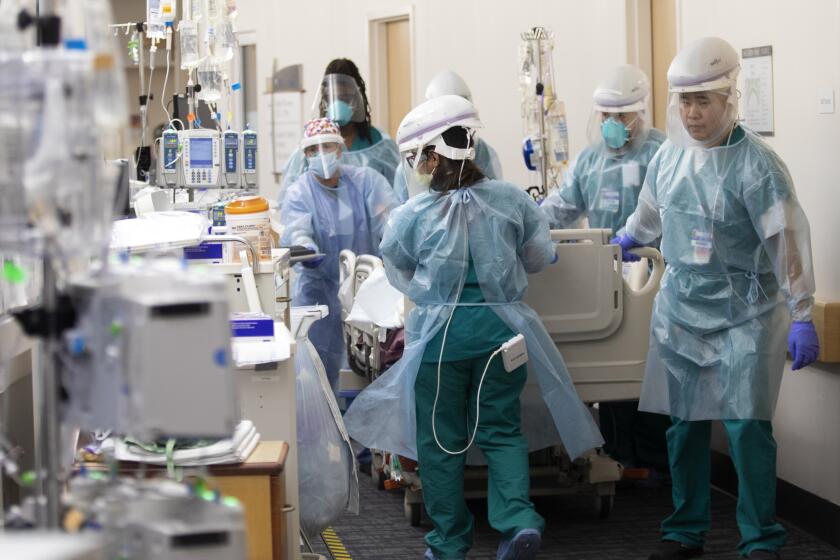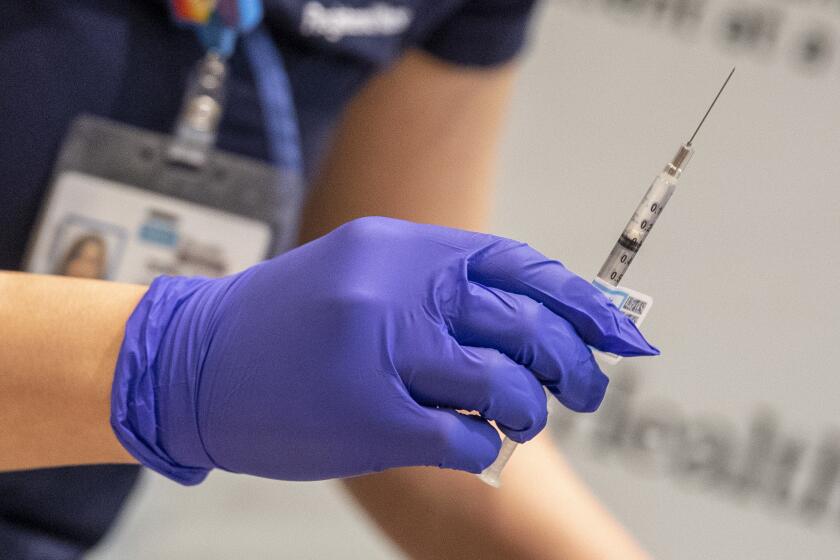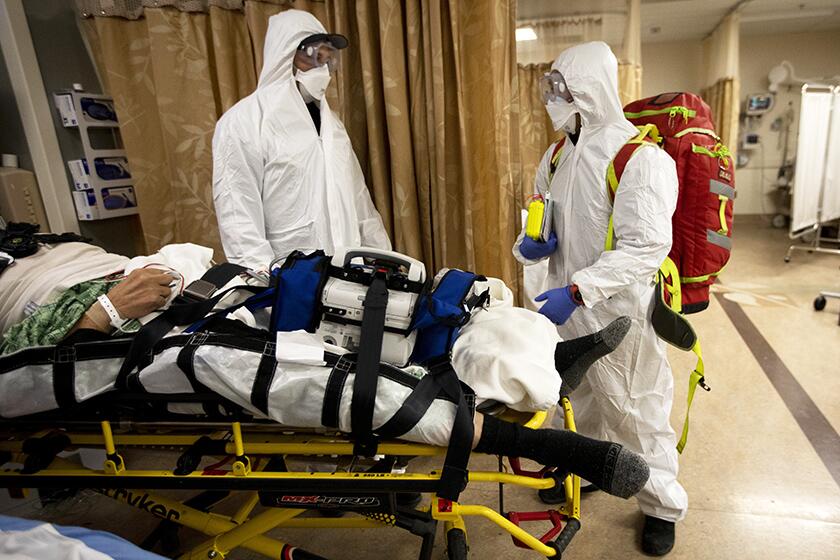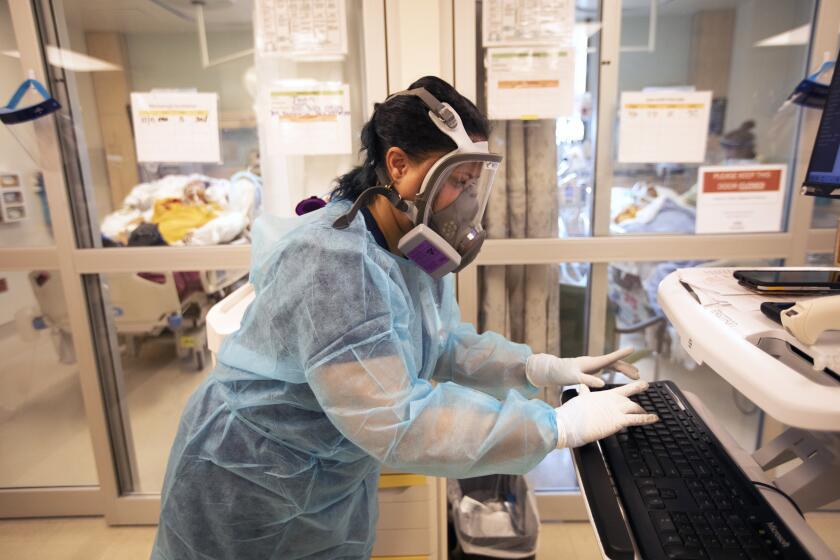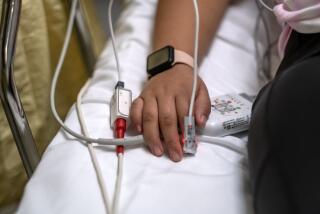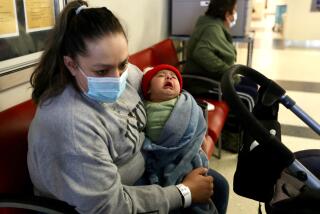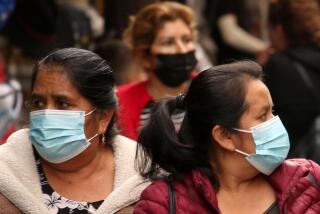L.A. County issues most dire coronavirus warnings yet: Hospitals in crisis as death toll surges toward 10,000
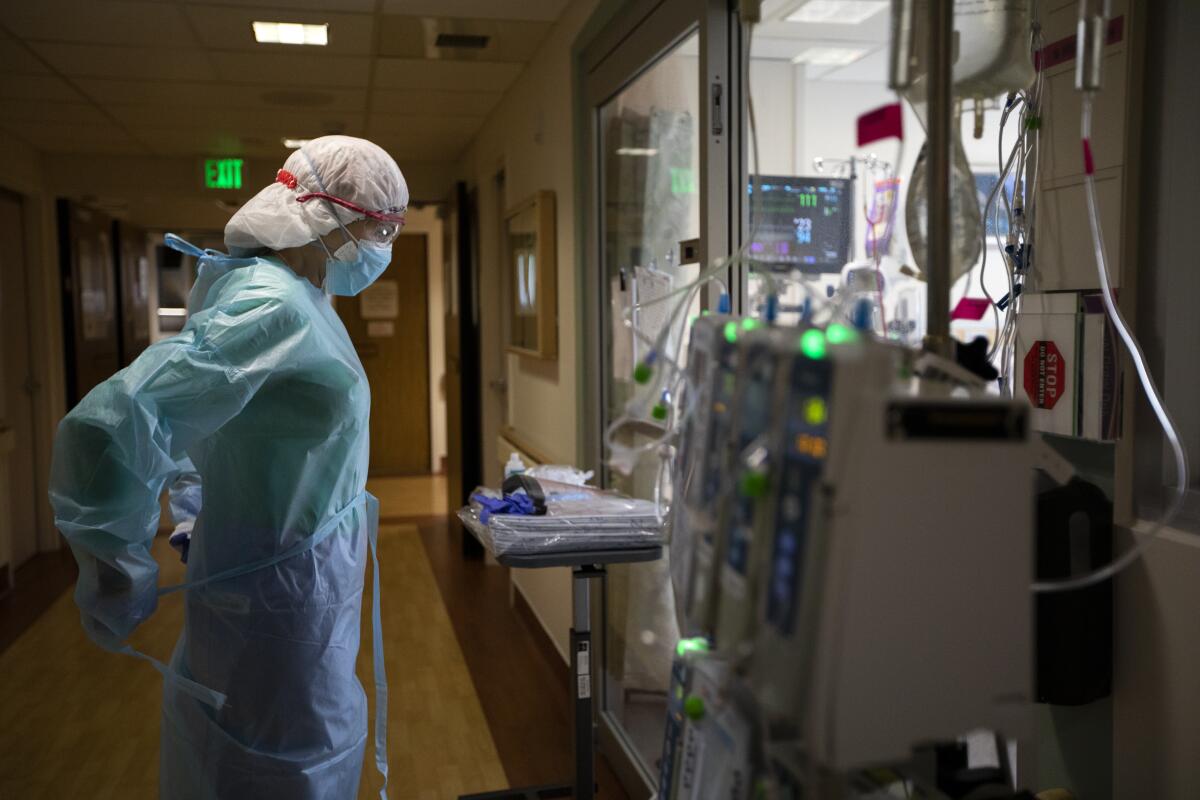
- Share via
Health officials in hard-hit Los Angeles County issued their most dire warning yet about the coronavirus, saying Monday that hospitals are at risk of running out of space, especially with the looming threat of a Christmas-fueled surge.
The county could top 10,000 total COVID-19 deaths in a matter of days.
Hospitals are so inundated that they’ve resorted to placing patients in conference rooms or gift shops. Some are contending with aging and insufficient infrastructure that threatens to interrupt the flow of life-saving oxygen.
New daily case counts, though not climbing exponentially as they were earlier in the surge, remain distressingly high.
On Christmas Eve, 140 people died from COVID-19 countywide — an average of one fatality every 10 minutes, according to data compiled by The Times.
“These are figures that can’t be normalized,” county Supervisor Hilda Solis said during a briefing Monday. “Just like the sound of ambulance sirens, we can’t tune this out.”
Overall, 9,564 L.A. County residents are reported to have died from COVID-19. Health officials said Monday they are sorting through a reporting backlog they expect will add 432 deaths to the toll.
“As bad as it is, the worst is almost certainly yet to come,” said Dr. Christina Ghaly, the county’s health services director.
“The situation,” she added, “is truly dire.”
L.A. was far more vulnerable to an extreme crisis from the coronavirus than nearly anywhere else in the nation.
According to the latest state data, there are 7,181 COVID-19 patients hospitalized in L.A. County; 1,449 of them are in intensive care units. Both figures are the highest seen at any point in the pandemic.
Ghaly said Monday that approximately 50% of the county’s currently staffed beds, and just over two-thirds of staffed ICU beds, are filled by COVID-19 patients.
Among the four county-operated hospitals, a stunning 86% of ICU patients have COVID-19, Ghaly said. The majority of nonessential surgeries and procedures in those facilities have been postponed, and officials are working to discharge patients to skilled nursing facilities, outpatient dialysis sites and other locations.
Virtually all hospitals in L.A. County are being forced to divert ambulances with certain types of patients elsewhere because they are too crowded. On Sunday, 94% of the county’s hospitals that take in patients from 911 calls were diverting some patients in ambulances.
There are situations in which 10 ambulances are waiting to offload patients at emergency rooms, forcing patients to be treated in the vehicles for as long as eight hours.
Collecting personal data from vaccine recipients can help determine efficacy and safety. But it’s raising privacy worries among those who help immigrant communities.
Hospitals are also having problems getting oxygen to critically ill COVID-19 patients who are struggling to breathe. Such problems on Sunday caused at least five hospitals in L.A. County to declare an internal disaster, which closes them to all ambulance traffic.
The problem, Ghaly said, is a shortage of the oxygen canisters needed so patients can return home while receiving treatment, as well as the breakdown of aging hospital pipes that are buckling under huge demand.
In light of the deteriorating situation, Gov. Gavin Newsom announced Monday that the state will embed a new support team in L.A. County to encourage load leveling and “greater coordination between the hospitals.”
An overwhelmed and overtaxed healthcare system, he pointed out, imperils anyone who needs professional care — not just those infected with the coronavirus.
“Routine emergency room care is being slowed down,” he said. “So if you think this doesn’t impact you, if you think somehow you’re immune from the impact of COVID, there’s the direct impact, and that is the transmission of this virus; there’s the indirect impact, God forbid, you have a stroke or a heart attack, you have a car accident or you have other acute care needs. The impact of this virus, this pandemic, is being felt on the entire hospital system.”
The latest maps and charts on the spread of COVID-19 in Los Angeles County, including cases, deaths, closures and restrictions.
At Los Angeles County-USC Medical Center, the situation reached “massive crisis” mode Sunday evening, according to chief medical officer Dr. Brad Spellberg.
There was not one available bed for at least 30 patients who needed intensive or intermediate levels of care, Spellberg said, and the hospital had to shut its doors to all ambulance traffic for 12 hours.
Patients, including some who were very sick and required intensive oxygen, experienced wait times as long as 18 hours.
“We were just completely overwhelmed,” Spellberg said, adding that the hospital is trying to “daily, hourly, cobble together solutions to get us through this crisis.”
Conditions at the hospital — one of the largest trauma centers in the western U.S. — have been steadily worsening since Thanksgiving, with an average of 10 new COVID-19 patients arriving each day.
As of Monday, the hospital had about 240 COVID-19 patients in all areas of the hospital, according to Spellberg, nearly twice the amount as during the July surge.
And the expected “Christmas bump” hasn’t even begun.
“When you walk into the ICU, and you see every bed occupied by a ventilated COVID patient, with tubes coming in all orifices of their body, you begin to understand that we are not dealing with what we were dealing with 10 months ago,” Spellberg said.
Officials are not sure how bad the post-Christmas coronavirus surge will be, but many experts say January is looking to be a ‘grim month.’
Hospitals across the county and state have already been forced to take significant steps to contend with the deluge of COVID-19 patients — such as putting off some procedures, keeping patients on ambulances for hours until space is available and moving some patients who would typically be in the ICU to other areas of the hospital.
However, those measures can go only so far, and healthcare officials warn that capacity is limited by not just physical space but by the scarcity of trained staff.
Should the medical system be stretched too far, officials warn, there may not be sufficient staffing or resources to provide critical care to all who need it, which would significantly increase the mortality rate.
“The sad reality is that all indicators tell us that our situation may only get worse as we begin 2021,” said L.A. County Public Health Director Barbara Ferrer. “The rate of community transmission remains extraordinarily high, and this has taxed our hospital system, as more COVID-19 patients continue to stream in, on top of the thousands of patients already fighting for their lives.”
In extreme circumstances, hospitals could be forced to ration care — with doctors no longer pulling out all the stops to save a life and instead strategizing about where to most effectively use resources and equipment.
Huntington Hospital in Pasadena is warning of that grim possibility in an information sheet for patients and their families.
Should the situation “reach a point where our hospital faces a shortage that will affect our ability to care for all patients,” officials wrote, then a clinical committee consisting of doctors, a community member, a bioethicist, a spiritual care provider and other experts “will review the cases of all patients who are critically ill” and “make necessary decisions about allocating limited medical resources based on the best medical information possible and will use the same decision criteria that is being used nationally and throughout California on all patient cases.”
“This unburdens bedside staff from making any decisions about triaging care when resources are scarce, and instead delegates those to a committee who will follow an ethical framework for decision-making,” hospital officials added in a statement Monday. “Importantly, no one person will make a caregiving decision, and the committee will be given no information about patient race, ethnicity, religion, citizenship, insurance or any other information unrelated to the patient’s health.
“We are committed, as always, to providing compassionate care to all and wholeheartedly thank our frontline healthcare workers, physicians and staff members who help run our hospital,” the statement continued.
Kaiser Permanente is also postponing non-urgent and elective surgeries and procedures at its facilities throughout California.
The pause will remain in effect through Jan. 10 in Kaiser’s Southern California region and through Jan. 4 in Northern California, according to statements from the healthcare consortium.
In Southern California, Kaiser is not scheduling any new elective surgeries through the end of January.
Cancer-related surgeries will continue, as will procedures in “any situation in which postponing surgery would have a negative impact on the patient’s medical condition, including pain,” officials added in a statement.
Delaying less-urgent procedures is necessary, officials said Monday, “to respond to the current and forecasted increases in COVID-19 cases” and free staff up “to concentrate on supporting COVID-19 care.”
“We are facing an unprecedented surge of patients with COVID-19, and the number of available ICU beds continues to dwindle,” Kaiser officials said in a statement Monday. “Last week, 52% of our hospitalized patients in Southern California were being treated for COVID-19. Today, that number has soared to 82%.”
Given the sheer number of patients, Kaiser is “converting and using every available space possible, including former conference rooms, waiting rooms, recovery areas and other nontraditional areas in the hospital.”
“We are very proud of the expertise and compassion that our employees and physicians have demonstrated every moment over the past nine months, and are continuing to provide amid the current surge in COVID-19 in our communities,” the statement continued. “But the current surge means our nurses, physicians and all of our staff — who are already stretched and tired — must extend themselves even more, to care for more and more patients. We are very concerned about what will happen in the coming days and weeks if we do not all take action to slow the spread of this virus.”
The increase in the number of coronavirus cases will likely result in an extended stay-at-home order for Southern California and other areas.
As of Sunday, the most recent day for which complete data are available, there were 19,766 COVID-19 patients hospitalized statewide — an all-time high, and 45% more than two weeks ago. Of those patients, 4,228 were in intensive care, also a record.
Health officials fear those numbers will continue to balloon, should the state experience a surge of infections stemming from Christmas travel and gatherings.
The patients who are in the hospital now reflect coronavirus infections diagnosed two weeks earlier. That means hospitals are still expected to see increasing demand into the new year because of infections that took place in early December.
Any fallout from Christmas will take weeks to fully assess, but officials have warned that the healthcare system cannot contend with another surge like the one after Thanksgiving. Nevertheless, state officials said Monday they think another holiday-fueled spike is on the horizon.
“We certainly anticipate that the middle of January is going to be a pretty difficult time in our hospitals, where the cases from this week and next week really start to stack on top of one another — impacting the emergency rooms, our hospital wards and our ICU spaces,” said Dr. Mark Ghaly, California’s health and human services secretary.
There’s real fear that such a “surge on top of a surge” could be too much for overworked hospital staff.
“It is a very, very different and infinitely more dangerous situation to have hospitals experiencing a surge when the staff are exhausted, they’re stretched thin, and they’re already caring for more patients than they can safely handle,” Christina Ghaly said.
The state imposed strict limitations on businesses and activities earlier this month in hopes of slowing the spread of infection.
Though the wave of new coronavirus cases has continued to swell since then, officials noted that the rate of that rise, along with the number of new coronavirus-related hospitalizations, appears to be leveling off in many areas.
“We’re seeing now a majority of the state experiencing a plateauing of new hospital admissions ... actually seeing that rate of growth beginning to subside, with one major exception — and that’s Southern California,” Newsom said Monday, as Los Angeles, Riverside and San Bernardino counties continue to report heavy infection numbers.
More to Read
Sign up for Essential California
The most important California stories and recommendations in your inbox every morning.
You may occasionally receive promotional content from the Los Angeles Times.
